How to Create More Capacity in Data Center
petak , 07.10.2016.With the ever-increasing demand for more computing power and data center servers, data center manager have the responsibility to chart a data center capacity plan and determine what strategy will accommodate business needs best. Of course, they could just expand to large facilities (upgrading to the advanced switch and fiber enclosures). However, not all IT budgets are increasing, and many users just cannot afford the extra money. Therefore, people are turning to high-density and cost-effective infrastructures. To support these applications, this article will introduce a broad selection of high-density connectivity and high capacity cable management devices.
- High-Density Patch Panels
High-Density (HD) fiber patch panel solution is the most convenient approach for solving the problem of limited capacity in a data center environment. And it provides a flexible way to connect devices of different generations of equipment quickly and easily. HD patch panels consist of a panel enclosure and modular HD cassettes, which can connect a fiber network feed (via multi-strand or MTP cable) and segment it into standard LC connections in order to interface with 10Gbps devices. The following image shows a fiber adapter panel with 12 LC duplex single-mode adapters.
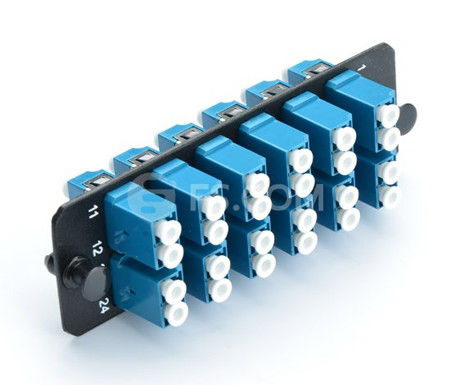
HD fiber patch panels feature the following advantages:
Flexibility: They can connect different generations of equipment such as 10Gb, 40Gb, 100Gb in a simple panel-cassette system with different connector types.
Ease of Installation: No tools are required to install the cassette in the panel enclosure. Each cassette features factory terminated connectors that reduce the time and labor required of field connector terminations.
Cost-Effectiveness: High-density and ease of installation provide a low initial investment cost. Flexibility, adjustability and reliability provide a high ROI. What’s more, network reconfiguration is highly adjustable due to the modular cassette system.
- High-Density Patch Cords
As cabling density increases along with the deployment of higher network speeds, HD patch cords deliver a robust design to withstand the rigorous of daily use. Cables that can offer a smaller overall diameter improve cable management by installing in dense patch cord trays that take up less space. They also provide better airflow to maintain consistent operating temperatures, reducing the likelihood of failure or downtime.
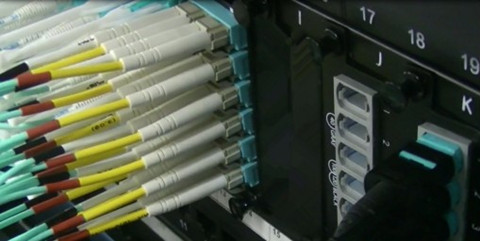
Finger access to each patch cable, furthermore hinder the cable management and makes the cable installation become more difficult. To ensure easy access, high-density patch cords are easy to remove through the use of a flexible pull-tab fiber optic cable just as seen in the above picture. This cable type has the same component and internal structure as the traditional patch cords (e.g.SC FC patch cord), except the a tab attached to the connector, which makes it easy for cable management. These tabs can help increase cabling density and maintain reliability, preventing you from accidentally loosening surrounding connectors as you access the patch cord you need.
MPO/MTP trunk cable is the another example of the HD patch cords. These cables are the foundation of easier, faster and better pre-terminated fiber connectivity solutions, as it allows tighter trunk cable bends for slack storage and routing. With the high-density trunks in your data center solution, less space is consumed and installation is easier.
- High-Density Fiber Enclosures
Fiber enclosure makes full used of the spaces in data center by combining most of the fiber optic connections in strong standards modules, providing solid protection of data center links and increasing cabling density. Therefore, data center managers can get easy access to fiber connections and easy cable management. Accordingly, the cost for data center installation and maintenance can be effectively reduced.
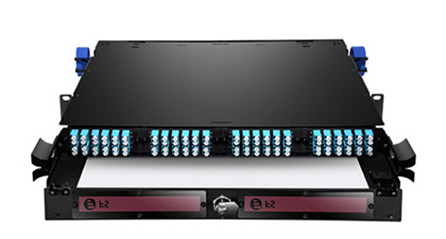
Fiber enclosures are usually available in 1U, 2U, 3U, 4U. The 1U rack mount fiber enclosure is the most commonly used one on the market. Now 4U or larger rack mount fiber enclosures are also becoming popular driven by the increasing of fiber counts in data center. Except standards rack mount fiber enclosures, a lot of data centers or server rooms use customized fiber enclosures for their special requirements.
FS.COM FHD Series rack mount fiber enclosures are available in 1RU, 2RU and 4RU rack unit options. With optional FHD cassette modules or adapter panels in single-mode, multimode, or 10G multimode versions, users can install, maintain, and upgrade their cabling systems in a more flexible and cost-effective way. In addition to rack mount solution, our FHD series products also support wall mount type which can meet the cabling demands on fiber industrial environments.
Conclusion
High-density optic solutions enable data center operators to maximize the amount of active equipment and cables in a data center by minimizing the foot print of the networking infrastructure. Besides the above HD optical products, there are also a range of HD products including the high speed interconnect optics, cable assemblies, cable management hardware. If you want to know more about the HD products from FS.COM, please have a look at our website.
Oznake: data center, fiber Patch Panel, MPO/MTP trunk cable, Fiber Enclosure
komentiraj (0) * ispiši * #
10G Data Center Cabling Solutions
srijeda , 07.09.2016.The rapid development in data center throughput has led to the increasing usage and demand for higher-performance servers, storage and interconnects. And the old 1G Ethernet cannot handle the heavy-loaded solutions in data center any more. As a result, datacenter designers are looking to the expansion of higher speed Ethernet solutions, specifically 10 G and 40G Ethernet. As for 10GbE, there are two broad categories—SFP+ optical options and 10GBASE-T available on the market, which pose difficulty in selecting the appropriate 10-gigabit physical media. This article will make a brief introduction to these two 10G solutions to help you choose the suitable one.
What Is 10G SFP+?
10G Small-form-factor pluggable plus (SFP+) is the industry standard for data rates up to 10 Gbps, which is also MSA compliant. SFP+ module is especially standardized for 10 Gbps application, and is identical in dimensions to the SFP. To achieve the SFP+ form factor reduction, only the optical-to-electrical and electrical-to-optical conversion functionalities occur inside the optical module. The key advantage of SFP+ over the existing 10 G optical interconnects is the higher port densities enabled by its dimensions, and lower power consumption. Figure 1 shows a SFP+ modules connected with a LC to LC patch cord.
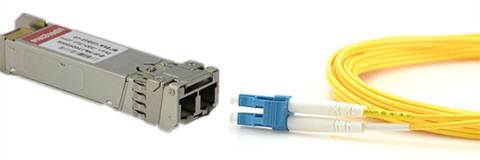
SFP+ transceivers are available in different 10G Ethernet standards—10GBASE-SR, 10GBASE-LR, 10GBASE-LRM, 10GBASE-ER, 10GBASE-ZR, 10GBASE-LX4 and 10GBASE-PR. Each standard has a unique specification that can be suitable for different applications. SFP+ optics are selected more often when designers need faster and more reliable solutions to handle 10 Gigabit Ethernet optical lines. With lower power usage and low latency, SFP+ ports are most commonly used for enterprise switches and also for plug-in cards for servers.
How Does 10G Copper Solutions Compare?
10G Ethernet can also run over twin-axial cabling, twisted pair cabling, and backplanes. SFP+ direct attach cable, 10GbASE-CX4 and 10GBASE-T are the common copper solutions for 10G short-reach interconnect. 10GBase-CX4 achieves the aggregate rate of 10 Gbps by transmitting over four independent cables at 3.125 Gbps. The disadvantage of this solution is the bulkiness of the cables that have eight twin-ax cables within them for a duplex link. And the bulkiness of the cables makes cable management more difficult. This becomes a significant limitation as the port densities and inter-port connection densities increase. Additionally, the number of conductors make these cables expensive compared to SFP+ cables.
10GBase-T enables 10 Gbps transmissions over Cat 6 and higher quality cables using complex signal processing and channel coding. The potential advantage of this technology is its extended reach. The extended reach and ability to enable structured cabling are not required for the short reach interconnects between servers and switches collocated in a rack. The disadvantages are its high power consumption and latency. The high latency in particular is a key limitation in latency sensitive data center and storage applications.
SFP+ Direct Attach DAC is another lower cost alternative to fiber with a limited link length of 7 meters. Additionally, it has significant power, cost, and performance advantages over the above media as explained below.
Why Use 10G DAC Cables in Data Center?
As 10 Gbps interconnects become ubiquitous in servers, providers are looking for a low cost, low power, and space efficient interconnect solution for the short reach (5-7m) links that dominate the data center environment. A length of seven meters covers all connections between server cards and switches, typically mounted on a single data center rack, and a vast majority of inter-rack connections. The SFP+ Direct Attach Copper is the 10G interconnect technology that matches these requirements, playing a vital role in enabling the next generation power and cost efficient data centers.
SFP+ Direct Attach Copper Solution
To further reduce cost and power in interconnect distances of 7 meters, which is sufficient to link server cards and switches, the SFP+ Direct Attach Copper replaces the optical modules and fiber with a passive copper cable with connectors identical to an SFP+ optical module. Figure 2 shows a SFP-H10GB-CU3M plugging in a Cisco switch. The reduction in cost and power are significant since the price of two optical modules required to support a full duplex link is approximately 10 times the cost of a fully connectorized SFP+ Direct Attach cable. In addition, the optical SFP+ modules consume around 1W each, adding 2W per port to the overall system power budget and cooling requirements.
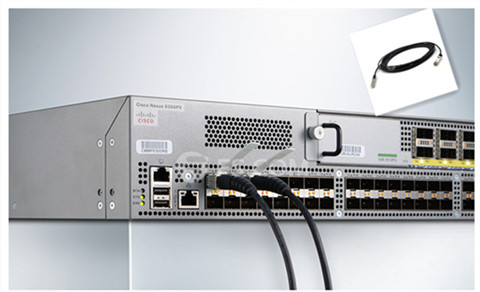
Data is transmitted as 10 G serial NRZ (Non Return to Zero) symbols with transmit pre-emphasis and receive equalization compensating for Inter Symbol Interference caused by the board trace and the copper cable. This choice of serial NRZ transmission over a passive medium makes SFP+ copper both a low power and low latency solution compared to its alternatives.
Conclusion
As more emphasis is placed on energy efficient data centers and higher bandwidth applications, the need for a small form factor, low power, low latency and low cost interconnect makes SFP+ Direct Attach the optimal solution for short-reach 10G interconnects. While SFP+ fiber options provides a great path for higher performance long haul applications. FS.COM is a top manufacturer for DAC Twinax cables (SFP+ Cables, XFP Cables, CX4 Cables, Infiniband Cables, etc) and best suppliers for QSFP+ products including 10G & 40G QSFP+ copper and AOC cables. Optics transceivers like QSFP+, SFP, SFP+, XFP, X2, XENPAK, SDH, Bidi are also offered. If you have any interest in our products, you can contact us directly.
Oznake: data center, 10G cabling, SFP, DAC cables, LC to LC patch cord, SFP-H10GB-CU3M
komentiraj (0) * ispiši * #
